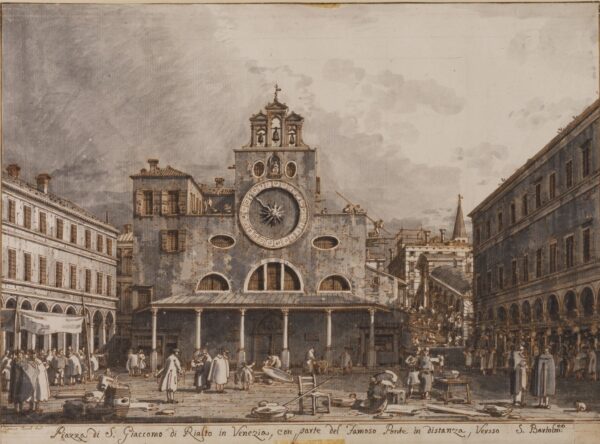Just as Venice is a magnet for tourists, the city is a perennial subject for galleries and museums. Today we can’t get enough of La Serenissima, ‘the most serene’, and the situation was pretty much the same in the eighteenth century. Although this period marked a decline for Venice in terms of its political and maritime reputation, the city’s explosion of creativity was nothing less than a phenomenon; its art and architecture, along with its advances in opera, its Carnival and its reputation for sexual license, all attracted visitors in their droves.

Giovanni Antonio Canaletto (1697 – 1768), Piazza San Giacomo di Rialto, 1760 – 69, The Courtauld, London (Samuel Courtauld Trust)
This small but impeccably chosen collection of 20 drawings, curated by Marco Mansi, PhD candidate and Print Room Assistant at The Courtauld (with assistance from Ketty Gottardo, Curator of Drawings), is therefore mainly focussed on the art produced for an international audience. It makes good use of the Courtauld’s collection, providing a viewpoint beyond the usual Canaletto-heavy displays to include artists such as Giovanni Battista Tiepolo, Francesco Guardi, Giovanni Battista Piazzetta and Bernardo Bellotto.
The advantage of looking at drawings, as opposed to oils, is that they can give an off-duty impression of the artist – some sketches are rather like diaries, revealing a mind at work. For example, Giovanni Domenico Tiepolo’s A Ball at the Ridotto (c. 1757) is both a joyous sketch of partygoers – all speed and energy – and an insight how he constructed paintings like The Minuet. Conveniently there are magnifying glasses on hand for visitors to the exhibition, which certainly helps with detailed works like these.
Other exhibits offer a counterpoint to Venice’s serious, religious art by illuminating local characters and traditions. Pietro Antonio Novelli – mostly known for his altarpieces and frescoes – makes an unexpectedly droll appearance with his sketch of a gnocchi seller (1770s). Gnocchi Friday is celebrated on the last Friday before Lent during the Carnival in Verona (a city under Venetian rule in the eighteenth century) and Novelli shows us a man in Punchinello costume, holding a long fork with a floury dumpling impaled on it.
Another tradition is the Venetian Sensa (Ascension Day) feast, during which a ring is thrown into the lagoon to symbolise the marriage between the city and the sea. In the eighteenth century this role was performed by the Doge, who sailed to the Lido in his gilded barge: the Bucintoro. It was a popular spectacle for tourists – Canaletto painted the subject, as did his follower, Francesco Guardi, both of whom produced scintillating views of the barge glittering on turquoise waters. Here, we are treated to a sketch by Francesco Guardi of the same event, though the monochrome pen-and-wash gives a completely different impression; the Bucintoro is barely noticeable compared to the febrile treatment of the architecture and water traffic.
Speed is one of the main advantages of drawing, both in terms of a quick sale (no waiting for paint to dry or problems with shipping unwieldy canvases) but also because techniques like pen and wash allow artists to capture the city’s energy. Giacomo Guardi’s three views of Venice – one of the few works in the exhibition using colour washes – are cases in point. The scenes are familiar, but the use of watercolour and the clothes of the visitors capture the Grand Tour as it approached the nineteenth century. (Although the exhibition avoids overloading the viewer with too much information, a few artist biographies would have been useful to separate different members of the Guardi and Tiepolo families.)
Despite its even-handedness, La Serenissima can’t escape the influence of Giovanni Antonio Canal – known as Canaletto. The most compelling drawing on display is arguably his Piazza San Giacomo di Rialto (1765-1768), showing a little square leading off from the Rialto Bridge. Right in front of us is the Church of San Giacomo di Rialto (supposedly the oldest in Venice) with its bell tower and fifteenth-century clock.
The scene is full of scurrying figures but has an atmosphere quite different from his famous view paintings: all eggshell-blue skies and boldly shadowed buildings. For one thing, Canaletto often painted directly onto his canvases (as was the Venetian tradition) without creating an under-drawing to guide him, therefore drawings like Piazza San Giacomo di Rialto should be seen, not as preparatory studies, but as artworks in their own right.
In addition to showing Canaletto’s skill at capturing daily life, this is an interesting example of the artist’s mature work. Although much in demand during the height of the Grand Tour, Canaletto’s trade was eventually damaged by the War of the Austrian Succession, which cut off the flow of British visitors to Venice. He went to London for a period, producing fine views of the Thames from Richmond House, but was back in Venice by 1760, when a young Englishman spotted him sketching in the Piazza. The artist was delighted to be recognised and gave the man his sketch, promising to sell him the painting when it was finished.
It is sad to think of Canaletto reduced to sketching in the Piazza for tourists, but times had changed, and he was no longer able to command either the prices or the interest of his foreign clientele. If (as one contemporary put it) you can see the sun shining in his paintings, there is something elegiac about his drawings – they are still accomplished but feel more thoughtful; less flashy. As the caption informs us, Piazza San Giacomo di Rialto, though produced in the 1760s, must have been done from earlier sketches because the church belltower appears in its pre-1747 design. The clock shows us time marching on but, for Canaletto, his best days were already behind him.
